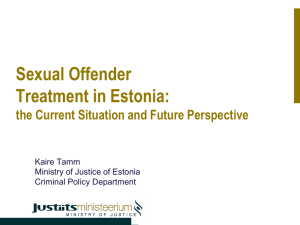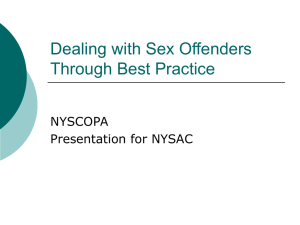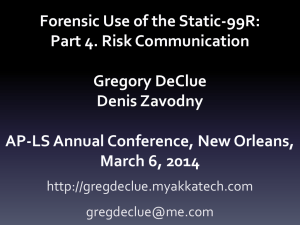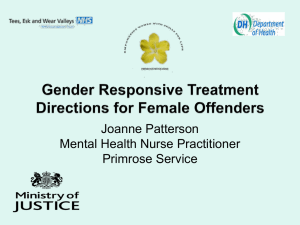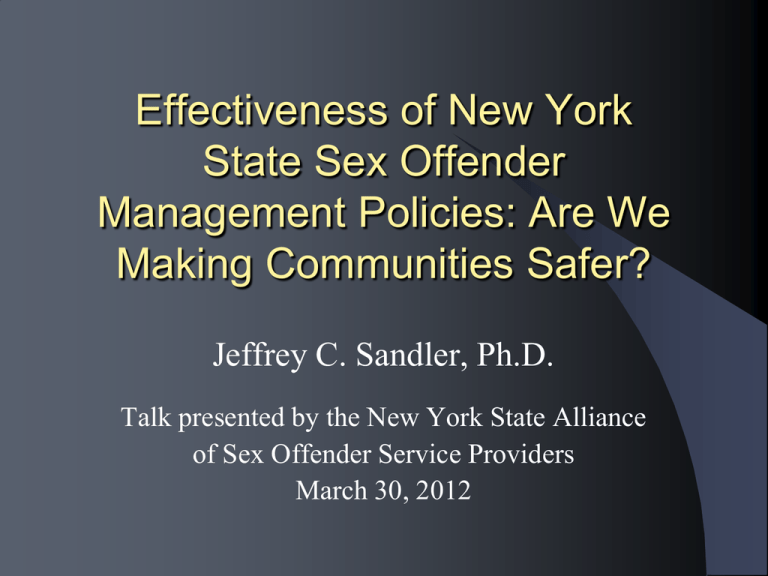
Effectiveness of New York
State Sex Offender
Management Policies: Are We
Making Communities Safer?
Jeffrey C. Sandler, Ph.D.
Talk presented by the New York State Alliance
of Sex Offender Service Providers
March 30, 2012
Purpose: Review the Public Safety
Research Literature
Registration and Community Notification
– Existing research
– The NYS offender-leveling instrument
Residency Restrictions
Civil Management
Part 1:
Sex Offender Registration and
Community Notification
Offenders in New York State
● Map says 32,994 as of November 4, 2011
● Ackerman, Levenson, & Harris (in press)
wanted to know how many were actually in
the community
– Examined the number of registered sex offenders
in five states, including NYS
– Took out offenders not in the community (i.e.,
living out of state, dead, civilly committed, and/or
deported)
– Were left with 15,950 in the community in NYS
Legislative History
Jacob Wetterling Crimes Against Children
and Sexually Violent Offender Registration
Act (1994)
Megan’s Law (1996)
Pam Lychner Act (1996)
New York State’s Sex Offender Registration
Act (SORA; 1996)
Campus Sex Crimes Prevention Act (2000)
Adam Walsh Child Protection and Safety Act
(2006)
Research on the Impact of Sex
Offender Registration and Notification:
Evaluations using Offenders
● Schram & Milloy (1995): No significant
difference in re-arrest rates between registered
(n = 90) and unregistered (n = 90) sex offenders
in Washington State
● Adkins, Huff, & Stageberg (2000): No
significant difference in sexual reconviction
between 201 sex offenders released in Iowa
prior to registration enactment and 233 sex
offenders subject to notification (sexual
reconviction rates of 3.5% and 3.0%,
respectively)
Research on the Impact of Sex
Offender Registration and Notification:
Evaluations using Offenders (cont.)
● Duwe & Donnay (2008): Examined the impact
of community notification using a notification
group (n = 155), a pre-notification group (n =
125), and a non-notification group (n = 155) in
Minnesota and found notification to
significantly reduce odds of sexual recidivism
Freeman (in press): NYS sex offenders subject
to notification were re-arrested more quickly and
at a higher rate for sexual offenses than those
not subject to notification requirements after
controlling for supervision effects
Research on the Impact of Sex
Offender Registration and Notification:
Evaluations using Crime Rates
Barnoski (2005):
– Findings:
Rates of sexual felony recidivism dropped after 1990
passage of registration law
Rates of sexual felony and violent felony recidivism
dropped after 1997 amendment of the notification law
– Study limitations:
Like the previous studies, only looked at recidivisms
Only examined rates through percentage comparisons
and binary logistic regression, so ignored natural changes
in the crime rate
Research on the Impact of Sex
Offender Registration and Notification:
Evaluations using Crime Rates (cont.)
● Walker, Maddan, Vásquez, VanHouten, &
Ervin-McCarthy (2005):
– Findings:
Six states experienced no change in rape arrest rates
Three states experienced a drop in rape arrest rates
One state experienced an increase in rape arrest rate
– Study Limitations
Used UCR data: Could not separately model
recidivisms, first time offenses, or different sex offenses
Modeled no non-sexual offense series for comparison
Research on the Impact of Sex
Offender Registration and Notification:
Evaluations using Crime Rates (cont.)
Zgoba, Witt, Dalessandro, & Veysey (2008)
– Findings:
Statewide sexual offense rates steadily decreased from
1985 to 2005
No consistent effect of Megan’s Law at county level
Costs an average of about $265,000 per county per year
to maintain the registry (mostly for staff)
Limited effect of Megan’s Law may not justify expense
– Study Limitations:
Used UCR data: Could not separately model
recidivisms, first time offenses, or different sex offenses
Using a New York State Sample
Does a Watched Pot Boil? A Time-Series
Analysis of New York State’s Sex Offender
Registration and Notification Law
Jeffrey C. Sandler
Naomi J. Freeman
Kelly M. Socia
Article published in:
Psychology, Public Policy, and Law (2008), 14, 284-302
Goals of the Study
● An empirical time-series analysis of the
impact of New York State’s 1996 Sex
Offender Registration Act (SORA)
● An attempt to understand how SORA’s
enactment influenced arrests rates
● An attempt to investigate how different
types of offending were impacted
Data
● Two hundred and fifty-two months (21
years) of statewide individual-level arrest
data from 1986 [10 years before SORA] to
2006 [11 years afterward]
● Aggregated to the state level
● Included every sexual offense arrest [and
therefore every sex offender arrested]
during that time
– Over 170,000 sexual offenses
– Over 160,000 different sex offenders
Series Modeled
● Test (9)
– Registerable sex offenses (RSOs)
• Total
• Recidivisms
• First time sex offenses
– Rapes
• Total
• Recidivisms
• First time sex offenses
– Child molestations
• Total
• Recidivisms
• First time sex offenses
● Comparison (8)
– Within group (sex offenders)
• Assaults
• Robberies
• Burglaries
• Larcenies
– Outside group (statewide)
• Assaults
• Robberies
• Burglaries
• Larcenies
RSO Arrest Counts
Results:
Basic offending statistics
● Most sexual offenses committed by first time
sex offenders (i.e., were not sexual recidivisms)
– Total RSOs: 95.88%
– Rapes: 95.94%
– Child molestations: 94.12%
Results:
Interrupted ARIMA
● All test and comparison series were found
to be ARIMA (0,1,1)(0,1,1)12 models
● Test series: No significant change
(increase or decrease) in the number of
monthly arrests in any of the sexual
offense series
Discussion
● Limitations
– Arrest and re-arrest only a proxy measures for offending
– Were not able to account for sex offenses committed in
another state
● Conclusions
– No evidence that registration and community notification
laws impacted rates of sexual offending
– Given that the vast majority of sexual arrests are of first
time (i.e., unconvicted) sex offenders, public policies
that target convicted sex offenders may be limited in
their ability to significantly reduce sexual offenses
Research on the Impact of Sex
Offender Registration and Notification:
Evaluations using Crime Rates (cont.)
Letourneau, Levenson, Bandyopadhyay,
Armstrong, & Sinha (2010)
– Findings:
A significant reduction in adult sexual offending
following the enactment of South Carolina’s sex offender
registry
No significant impact on sex offenses following the
enactment of South Carolina’s internet notification
– Study Limitations:
Only looked at first time offenses
Did not separately model different sexual offense types
Research on the Impact of Sex
Offender Registration and Notification:
Evaluations using Crime Rates (cont.)
Prescott & Rockoff (2011)
– Findings:
Reduced sexual offenses associated with:
– Broad registration without notification
– Only of cases when the victim knew offender (not stranger cases)
Reduced sexual offenses associated with notification when
applied narrowly…but increases when applied broadly
– Study Limitations:
Used NIBRS data: Could not identify recidivisms/first
time offenses, findings subject to reporting changes
Had big holes in their “registry size” variable
Research on the Impact of Sex
Offender Registration and Notification:
Evaluations using Crime Rates (cont.)
Agan (2011)
– Findings:
No significant impact associated with registry or
notification enactment
No significant difference in sexual recidivism rates for
offenders released before and after enactment
No relationship between the number of registered sex
offenders living in an area and sexual abuse rates
– Study Limitations:
Used UCR data
Had big holes in her “registry size” variable
Why No Impact in New York?
● Way the public is using registry and notification
information is limiting the potential impact
Research on the Public and
Registration and Notification
Phillips (1998):
– More than 60% of community members
believed registration and notification encouraged
sex offenders to behave better
– Over 50% of respondents:
No change in leaving children with babysitter or
unsupervised
No less likely to go out alone
No change in level of community involvement
Research on the Public and
Registration and Notification (cont.)
Anderson & Sample (2008):
– Almost 90% of respondents aware of the registry
– Only 35% had accessed it
– Over 60% of community members report taking
no preventative measures
– The most common preventative measure taken
was to pass the information along to
Children
Neighbors
Research on the Public and
Registration and Notification (cont.)
Kernsmith, Comartin, Craun, & Kernsmith
(2009)
– Over 94% of respondents aware of the registry
– Only 37% had accessed it: Families with young
children most likely (59%)
– Sex offenders found to live in 99% of zip codes
Only 27% of all respondents believed an offender lived
their community
Of those respondents who had accessed the registry,
51% believed an offender lived in their community
Research on the Public and
Registration and Notification (cont.)
Sample, Evans, & Anderson (2011):
– A study of internet registry access specifically
(which the authors feel is a more true test of the
impact of community notification than recidivism)
About 17% of the sample accessed the registry for
safety reasons
About 14% got their registry information from other
sources
– Did a bunch of regression analyses, but the
methodology was questionable
Why No Impact in New York?
● Way the public is using registry and notification
information is limiting the potential impact
● The way New York State operates its registry and
notification is limiting the potential impact
– May be an artifact of the system’s structure:
Letourneau et al. (2010) – Different (more broad) system
Prescott & Rockoff (2011) – Registration should be broad,
but notification needs to be narrow
– May be that SORA levels are not truly indicative of
sexual recidivism risk
The instrument has never been validated since its inception
(Guidry, 2004)
SORA risk-leveling instrument
Intended to assess two things:
– Likelihood of an offender sexually recidivating
(risk)
– Seriousness of the offense if the offender sexually
recidivates (harm)
Developed shortly after the passage of SORA
– Before much research on sex offender risk was
available (e.g., Hanson & Bussiére, 1998)
– Before many sex offender-specific risk
assessment measures were available (e.g., the
Static-99)
SORA risk-leveling instrument
Contains 15 items within four categories:
–
–
–
–
Current offense(s)
Criminal history
Post-offense behavior
Release environment
Various weights given to each item
Generates a total score ranging from 0 to 300,
which corresponds to a level designation
Allows for the possibility of an override
SORA risk-leveling items
Current offense(s):
– Use of violence
– Sexual contact with victim (e.g., over vs. under
clothing)
– Number of victims
– Duration of offense conduct with victim
– Age of victim
– Other victim characteristics (e.g., mentally disability)
– Relationship with victim
SORA risk-leveling items
Criminal history:
–
–
–
–
Age at first sex crime
Number and nature of prior crimes
Recency of prior felony or sex crime
Drug or alcohol abuse
Post-offense behavior:
– Acceptance of responsibility
– Conduct while confined/supervised
Release environment
– Supervision
– Living/employment situation
SORA risk-leveling instrument
Risk level assignment from score:
– 0-70 = Level 1
– 75-105 = Level 2
– 110-300 = Level 3
Four possible reasons for override (presumes a
Level 3 designation) if the offender:
–
–
–
–
Has a prior felony sex conviction
Inflicted serious physical injury or death
Made recent threat to re-offend sexually/violently
Has an abnormality that hinders his/her ability to
control impulsive sexual behavior
SORA risk-leveling instrument
According to the website of the New York
State Division of Criminal justice Services
(DCJS):
– 39% of all offenders are designated as Level 1
– 36% of all offenders are designated as Level 2
– 25% of all offenders are designated as Level 3
As stated earlier, there has been no validation
of the SORA risk-leveling instrument since its
inception
Study Goals
Investigate the predictive validity of the
SORA risk levels:
– Risk of sexual re-arrest
– Harm of sexual re-arrest
Investigate how the SORA risk levels
compare to other predictors of sexual
recidivism
Method: Data and Analyses
Data: A sample of 3,633 sex offenders
– Registered in New York State as of August 2005
– With 5 years of post-release follow up (study
censor date was January 2007)
Analyses:
– Basic frequencies and descriptives to examine
both risk and harm
– Receiver operating characteristic area under the
curve (AUC) to test predictive accuracy
Ranges
from 0.0 to 1.0 (AUC = 1.0 means perfect
prediction)
Prediction no better than chance is AUC = .50
Method: Study Variables
Outcome variables:
– Risk: Sexual re-arrest within 5 years of release
(no/yes)?
– Harm: New York State penal code arrest class
(misdemeanor/felony)?
Independent (predictor) variables:
– SORA risk levels: Those actually assigned (e.g.,
after overrides)
– Variables empirically-related to recidivism
Method: Comparison Models
Wanted to keep them simple and
straightforward:
–
Model 1:
• Age at release
• Prior RSO arrests
• Variety of offense
types
–
Model 2:
• Age at release
• Prior RSO arrests
• Variety of offense
types
• Stranger victim
Method: Analytic Strategy
Comparison models:
– Randomly split the sample in two:
Developmental
dataset (n = 1,831)
Validation dataset (n = 1,802)
– Generate risk models using logistic regression with
sexual recidivism within 5 years as the dependent
variable on the developmental dataset
– Test the predictive accuracy of the models on the
validation dataset
Assigned 39%, 36%, and 25% of offenders to
Levels 1, 2, and 3, respectively
Results: Risk
5-Year Sexual Re-Arrest Rates
Level
1
2
3
SORA
Levels
5.9%
6.5%
10.8%
Model 1 Model 2
3.5%
3.5%
7.9%
6.8%
13.6%
15.4%
Results: Risk
20.0%
Sexual Re-Arrest Rate
16.0%
12.0%
SORA Levels
Model 1
Model 2
8.0%
4.0%
0.0%
0
1
Sex Offender Level
2
Results: Risk
Predictive Accuracy
Level
SORA Levels
Model 1
Model 2
AUC
.572
.646
.667
95% CI
.537 - .607
.600 - .692
.620 - .713
AUC Results:
Assigned SORA level
AUC Results:
Model: Age, RSO Arrests, Variety
AUC Results:
Model: Age, RSO Arrests, Variety, Stranger
Results: Harm
Felony Sexual Re-Arrest Rates
Level
1
2
3
SORA
Levels
51.7%
60.5%
65.4%
Model 1
58.5%
59.6%
65.4%
Model 2
59.6%
56.2%
67.2%
Results: Harm
Predictive Accuracy
Level
SORA Levels
Model 1
Model 2
AUC
.543
.534
.548
95% CI
.473 - .613
.464 - .604
.478 - .617
Results: Harm
Rethought harm variable
– Recoded it to be continuous (i.e., B misdemeanor
through A-1 felony)
– Analyzed its correlation to the various risk levels
Level
SORA Levels
Model 1
Model 2
Correlation to Harm
.092
.109
.138
p
.125
.068
.021
Discussion
● Limitations
– Re-arrest only a proxy measure for re-offending
– Official arrest offense class is only a proxy measure for
seriousness of the sexual arrest
● Conclusions
– Risk
Assigned SORA risk levels do significantly predict 5-year
sexual re-arrest
Using logistic regression and just a few variables, it’s possible
to significantly improve risk prediction above SORA levels
– Harm
SORA risk levels do not significantly predict sexual re-arrest
offense class, whether coded dichotomously or continuously
One of the logistic models did significantly predict continuous
sexual re-arrest offense class
Summary:
Registration and Notification
Majority of research has found no significant,
systematic impact of the policies, however:
– Some emerging evidence of sexual crime reduction
associated with registration
– Some emerging evidence of sexual crime increase
associated with broad notification
No research to support the ability of registration
and/or notification to reduce child molestations
Summary:
SORA Risk-Leveling Instrument
NYS SORA-levels:
– Do significantly predict sexual re-arrest
– Do not significantly predict sexual re-arrest class
A simple logistic model:
– Can predict sexual re-arrest significantly better than
SORA risk levels
– Can significantly predict sexual re-arrest class if coded
continuously
Selected References: Registration and Notification
Barnoski, R. (2005). Sex offender sentencing in Washington State: Has community
notification reduced recidivism? Olympia, WA: Washington Institute for
Public Policy.
Freeman, N. J. (in press). The public safety impact of community notification
laws: Re-Arrest of convicted sex offenders. Crime & Delinquency. Available
though OnlineFirst at http://cad.sagepub.com/pap.dtl
Letourneau, E. J., Levenson, J. S., Bandyopadhyay, D., Armstrong, K. S., &
Sinha, D. (2010). Effects of South Carolina’s sex offender registration and
notification policy on deterrence of adult sex crimes. Criminal Justice and
Behavior, 37, 537-552.
Prescott, J. J., & Rockoff, J. E. (2011). Do sex offender registration and
notification laws affect criminal behavior? Journal of Law and Economics, 54,
161-193.
Sandler, J. C., Freeman, N. J., & Socia, K. M. (2008). Does a watched pot boil? A
time-series analysis of New York State’s Sex Offender Registration and
Notification, Psychology, Public Policy, and Law, 14, 284-302.
Schram, D. D., & Milloy, C. D. (1995). Community notification: A study of
offender characteristics and recidivism. Olympia, WA: Washington State
Institute for Public Policy.
Walker, J. T., Maddan, S., Vásquez, B. E., VanHouten, A. C., & Ervin-McCarthy,
G. (2005). The influence of sex offender registration and notification laws in
the United States. Retrieved June 1, 2007, from www.acic.org
Zgoba, K., Witt, P., Dalessandro, M., & Veysey, B. (2008). Megan’s Law:
Assessing the practical and monetary efficacy. Trenton: New Jersey
Department of Corrections.
Part 2:
Sex Offender Residency
Restrictions
Brief History
First enacted in Florida and Delaware in 1995
Usually restrict sex offenders from residing
within 1,000 to 2,500 feet of schools,
playgrounds, daycare centers, and other places
where children congregate
No statewide residency restriction law in NYS,
but there are numerous township, city, and
county laws (think the first was in 2005)
– The Office of Sex Offender Management (OSOM)
used to provide a list of these on their website
(See Meloy, Miller, & Curtis, 2008; Socia, 2011 for factors influencing the enactment of residence restrictions)
Intent and Basis
Attempt to protect children from sexual abuse
committed by previously convicted sex
offenders
Based on several assumptions related to
sexual offending:
– Sexual recidivism accounts for many, if not most,
instances of child sexual abuse
– The majority of child sexual abuse is perpetrated
by strangers
– Residential proximity to areas where children
congregate is related to sexual offending
Research on the Assumptions:
Recidivisms are the Problem
Nationwide, 87% of all individuals
arrested for sexual crimes had been not
previously convicted of a sexual crime
In New York State, only 5% of all sexual
crimes (and only 6% of all child
molestations) were committed by
individuals previously convicted of a
sexual crime
(Greenfeld, 1997; Sandler et al., 2008)
Research on the Assumptions:
Perpetrated by Strangers
Only about 18% of child sexual abuse
victims did not know their abuser (71% were
acquainted/knew by sight; 10% were family)
For elementary and middle school age
victims of child sexual abuse, only 5% were
abused by a stranger
For victims of sexual abuse under the age of
6, only 3% of the offenses were committed
by a stranger
(Finkelhor, 2008; Greenfeld, 1997; Synder, 2000)
Research on the Assumptions:
Residential Proximity
Chajewski & Mercado (2009)
– Sex offenders did not live closer to schools on
average than community members in towns and
counties (but did in cities)
– Sex offenders with child victims did not live
closer to schools than those without child victims
– Sex offenders with stranger victims did not live
closer to schools than those without stranger
victims
(see also Zgoba, Levenson, & McKee, 2009)
Research on the Impact:
Proximity and Offending
Minnesota Department of Corrections (2003)
– Examined the cases of all Level 3 sex offenders
who had been released in 1997-1999 (before the
enactment of the MN residence restriction) who
sexually recidivated before March 2002 (N = 13)
– Concluded:
“There were no examples that residential proximity to
a park or school was a contributing factor in any of
the sexual re-offenses” (p. 9)
“Enhanced safety due to proximity restrictions may be
a comfort factor for the general public, but it does not
have any basis in fact” (p. 9)
Research on the Impact:
Proximity and Offending (cont.)
Colorado Department of Public Safety (2004):
Sex offenders with an offense during the first
15 months of their post-release supervision
usually did not live within 1,000 feet of a
school or child care center
Blood, Watson, & Stageberg (2008): Iowa’s
residency restriction “does not seem to have
led to fewer charges or convictions, indicating
that there probably have not been fewer child
victims” (p. 10)
Research on the Impact:
Proximity and Offending (cont.)
Duwe, Donnay, & Tewksbury (2008)
– Used the files of 224 recidivistic sexual offenses
involving minors to examine relationship between:
The location where offenders made first contact with
their victims
Locations included in residency restrictions
– Found:
None of the child sexual recidivists contacted their
victims “near a school, park, playground, or other
location included in residential restriction laws” (p. 500)
Most offenders made first contact over a mile from their
home
Research on the Impact:
Proximity and Offending (cont.)
Zandbergen, Levenson, & Hart (2010)
– Matched 165 Florida sexual recidivists to 165 nonrecidivists on criminal history and victim variables
– Found:
Non-recidivists were significantly more likely than
recidivists to live within 2,500 feet of at least one school
No significant difference in the number of recidivists and
non-recidivists who lived close (whether defined as
within 1,000 feet or 2,500 feet) to day cares
No significant difference between recidivists and nonrecidivists in distance between home and school or day
care
Research on the Impact:
Proximity and Offending (cont.)
Nobles, Levenson, & Youstin (in press)
– Examined sexual offending trends before and after
Jacksonville, FL expanded its residency restriction
– Found:
No significant change in overall sexual crime rates
following expansion of the restriction
No significant change in recidivistic sexual crime rates
following expansion of the restriction
– Important to remember this was a test of
expanding the restriction to 2,500 feet, a 1,000foot restriction had been in place for years
Using a New York State Sample
The Efficacy of County-Level
Sex Offender Residence Restrictions in
New York
Kelly M. Socia, Ph.D.
University of New Mexico
University of Massachusetts, Lowell (2012)
Article accepted for publication and in press with:
Crime & Delinquency
Study Goals
Examine whether the enactment of county-level
residence restrictions was associated with rates
of recidivistic sexual offenses involving:
– Child victims
– Adult victims
Examine whether the enactment of county-level
residence restrictions was associated with rates
of non-recidivistic (i.e., first time) sexual
offenses involving:
– Child victims
– Adults victims
Method
Examined sexual crime rates in all 62 NYS
counties
– Recidivistic (looking for specific deterrent effect)
– First time (looking for general deterrent effect)
Compared the crime rates of counties that
enacted residence restrictions with those of
counties that had not, while controlling for
influences other than a residence restriction
– Temporal factors
– Factors impacting all types of crime (i.e., not
specific to sexual offenses)
Results
Enactment of a residence restriction:
– Had no significant impact on recidivistic sex
offenses against children
– Had no significant impact on recidivistic sex
offenses against adults
– Had no significant impact on first time sex
offenses against children
– Significantly reduced (by about 10%) the number
of first time sexual offenses against adults
Discussion
No evidence of any impact of residence
restriction enactment on sexual offenses with
child victims
Evidence of a general deterrent effect on sexual
offenses against adults
– First finding of its kind for residence restrictions
– Supports some emerging findings of a general
deterrent effect for registration
Letourneau et al. (2010) – Only for crimes sexual crimes
committed by adults
Prescott & Rockoff (2011) – Only for crimes where the
victim was not a stranger
Research on the Impact:
Unintended Consequences
An increase in sex offenders registered as
homeless in California by up to 60% (up
800% among parolees)
About 50% of residential space in Newark,
NJ restricted by a 1,000 foot restriction zone
Much affordable housing in cities is in
densely populated areas, which tend to
contain many schools and day cares
(California Sex Offender Management Board, 2008; Chajewski & Mercado, 2009; Tewksbury & Mustain, 2006)
Using a New York State Sample
The Policy Implications of Residence
Restrictions on Sex Offender Housing in
Upstate NY
Kelly M. Socia, Ph.D.
University of New Mexico
University of Massachusetts, Lowell (2012)
Article published in:
Criminology & Public Policy (20ll), 10, 351-389
Study Goals
Examine what the areas open to sex offenders
under a hypothetical statewide residence
restriction would look like in terms of housing:
– Density
– Availability (residences open for rent)
– Affordability (ratio of median area rent to fair market
rent)
– Social disorganization (e.g., unemployment, poverty)
Examine how varying the restriction size and
scope would impact housing options for offenders
Method
Examined neighborhoods in 47 of NYS’ 62
counties (excluded all counties that were way
outside national norms…sorry NYC)
Analyzed census block groups to examine
neighborhood characteristics
Applied hypothetical residence restrictions of
varying size and scope to the counties, then
compared characteristics of neighborhoods
with the most restricted housing to the
characteristics of neighborhoods with the least
restricted housing
Results and Discussion
Results: Neighborhoods that would have the
least amount of restricted housing (meaning
they would have the most housing left open):
–
–
–
–
Were less dense
Typically had less housing available for rent
Typically had less affordable housing
Were less disorganized
Discussion: From the research on successful
offender reentry:
– The first three results are barriers to success
– The fourth is a boon to success
Research on the Impact:
Unintended Consequences (cont.)
Levenson & Cotter (2005): Offenders report
increased:
– Financial and emotional hardships
– Difficulty obtaining employment, finding
affordable housing, and sustaining relationships
with pro-social support networks
Tewksbury & Mustaine (2006): Force sex
offenders to reside in mostly rural areas
where there are few employment, treatment,
and educational opportunities
(see Lasher & McGrath, 2012 for the unintended consequences of community notification)
Research on the Impact:
Unintended Consequences (cont.)
Willis & Grace (2008, 2009)
– Developed a release plan quality measure for sex
offenders being released in New Zealand
– Compared scores of recidivists and non-recidivists
– Sexual recidivists had significantly poorer:
Housing plans (2008)
Social support (2009)
Employment plans (2008, 2009)
– Important to remember this was only a measure of
release planning, not of release experiences
(see Meredith, Speir, & Johnson, 2007; Schulenberg, 2007 for research on housing and recidivism in non-sex offenders
Summary:
Residency Restrictions
Little research to show an impact on sexual
offending
– None showing an impact on child victim crimes
– Some showing an impact on adult victim crimes
No research to show sex offenders (specifically
child molesters) choose to live close to schools,
parks, and the like
Found to aggravate certain factors that inhibit
successful community reentry
Selected References: Residency Restrictions
Chajewski, M., & Mercado, C. C. (2009). An evaluation of sex offender
residency restriction functioning in town, county, and city-wide
jurisdictions. Criminal Justice Policy Review, 20, 44-61.
Duwe, G., Donnay, W., & Tewksbury, R. (2008). Does residential proximity
matter: A geographic analysis of sex offense recidivism. Criminal Justice
and Behavior, 35, 484-504.
Blood, P., Watson, L., & Stageberg, P. (2008). State legislation monitoring
report FY2007. Des Moines, IA: Author.
Minnesota Department of Corrections. (2003). Level three sex offenders
residential placement issues. St. Paul, MN: Author.
Socia, K. M. (2011). The policy implications of residence restrictions on sex
offender housing in upstate NY. Criminology & Public Policy, 10, 351-389.
Socia, K. M. (in press). The efficacy of county-level sex offender residence
restrictions in New York. Crime & Delinquency.
Zandbergen, P. A., Levenson, J. S., & Hart, T. C. (2010). Residential proximity
to schools and daycares: An empirical analysis of sex offender recidivism.
Criminal Justice and Behavior, 37, 482-502.
Willis, G. M., & Grace, R. C. (2008). The quality of community reintegration
planning for child molesters: Effects on sexual recidivism. Sexual Abuse: A
Journal of Research and Treatment, 20, 218-240.
Willis, G. M., & Grace, R. C. (2008). Assessment of community reintegration
planning for sex offenders: Poor planning predicts recidivism. Criminal
Justice and Behavior, 36, 494-512.
Part 3:
Sex Offender Civil
Management Laws
(a.k.a. Civil Commitment Laws,
Civil Confinement Laws, or
Sexually Violent Predator Laws)
Legislative History
Sexual psychopath laws of the 1920s and
1930s
Most of these repealed in the 1980s and 1990s
First modern sex offender civil commitment
statute passed by Washington State in 1990
New York enacted its Sex Offender
Management and Treatment Act (SOMTA) in
2007
Modern Civil Management Laws
Statutes vary slightly from state to state
Share certain key elements:
– Sexual crimes are particularly heinous
– Some sex offenders have mental abnormalities that
predispose them to engage in repeat sexual
offending
– Such offenders need specialized, intensive
treatment
– The offenders need to be monitored and/or
confined while receiving the treatment
New York State’s Sex Offender
Management and Treatment Act
Enacted April 13, 2007
All offenders about to be released on a qualifying
offense reviewed
Offenders must have:
– More than one victim (establish a pattern)
– High risk of sexual recidivism
– Mental abnormality related to risk of sexual recidivism
Two possibilities for management:
– Outpatient (SIST)
– Inpatient (confinement)
Civil Management Research on
Public Safety
Problems with studying the public safety impact:
– Many statutes are still new
– Highest risk offenders get confined (except in Texas)
Approaches to studying:
– Track offenders recommended for civil management
who never get managed
– Study a cohort of offenders matched to offenders
recommended for civil management
– Compare the sexual recidivism rates of offenders
screened out of civil management to unbaised samples
Research:
Recommended, but Not Managed
Three studies from Washington State:
– Schram & Milloy (1998)
N = 61, all released by DOC
4-year follow up
– Milloy (2003)
N = 89, all released by DOC
6-year follow up
– Milloy (2007)
N = 135, 123 released by DOC, 12 by another source
6-year follow up
In all three studies, offenders had a high rate of
sexual felony recidivism (range 23%-29%)
Using a New York State Sample
Evaluating New York State’s Sex Offender
Management and Treatment Act: A
Matched Historical Cohort Analysis
Larkin S. McReynolds
Jeffrey C. Sandler
Article accepted for publication and in press with:
Criminal Justice Policy Review
Study Goals
Determine which variables contributed
significantly to offenders being deemed high
risk and receiving a psychiatric exam
Assess the likely public safety impact of civil
management by examining the recidivism rates
of a historical sample of offenders matched to
SOMTA–reviewed offenders on variables
important to receiving a psychiatric exam
Method
Samples
– SOMTA cohort: All offenders reviewed under SOMTA
through November 2008 (N = 1,991)
– Historical cohort: All sex offenders released from DOCS
between 2000-2005 on what would have been SOMTAqualifying offenses (N = 4,807)
Study design
– Identify variables important to offenders being referred
for a psychiatric exam (the second level of review)
– Match the SOMTA-cohort to the historical cohort on the
important variables
– Examine recidivism rates of the matched-historical
cohort
Method (cont.)
Variables for matching:
–
–
–
–
Offender age at release (+/- 1 year)
Partial Static-99 (sum of Items 1, 3, 4, 5, 6, and 7)
Number of prior sexual offenses
Crime of conviction
Found matches for 1,546 offenders (78%)
Analyses
– Recidivism rates and survival analyses
– Dependent variable: Re-arrest for a sexual offense
within 5 years of release (yes/no)
Results
Re-arrested within:a
Raw Total
Re-arrested
a
1 Year
3 Years
5 Years
SOMTA Review
Outcome
n
%
n
%
n
%
n
%
No Psych Exam
100
7.3
11
0.8
49
3.6
69
6.6
Psych Exam
21
12.4
7
4.1
13
7.7
16
11.6
Total Sample
121
7.8
18
1.2
62
4.0
85
7.2
The 1-, 3-, and 5-year rates of re-arrest were calculated using only those offenders who had at
least 1, 3, or 5 years post-release.
Results
Discussion
Appears the SOMTA-screening process is
doing a good job of identifying higher risk
offenders, which implies SOMTA is likely
reducing instances of sexual recidivism
Difference in sexual re-arrest rates between
historical offenders whose SOMTA match
received a psychiatric exam and historical
offenders whose SOMTA match did not
receive a psychiatric exam was significant, but
moderate (5% over 5 years)
Using a New York State Sample
Risk Assessment and Sex Offender
Screening in New York
Naomi J. Freeman
Jeffrey C. Sandler
Article published in :
Sex Offender Law Report (2012), 13, 17-30
Study Goals
Assess the likely public safety impact of civil
management by comparing:
– The 3-year sexual re-arrest rate of offenders
screened out of the SOMTA-review process
– The 3-year sexual re-arrest rate of offenders
convicted of SOMTA-qualifying offenses, but
released before SOMTA was enacted
Method
Samples
– SOMTA cohort: All offenders reviewed under
SOMTA and deemed to not need civil management
through December 2010 (N = 3,999)
– Historical cohort: Sex offenders released from DOCS
between 2000-2005 on what would have been
SOMTA-qualifying offenses (N = 1,546)
Study design: Compute and compare sexual recidivism
rates across the two samples
Results
Sexual Re-arrest Rate
Follow-Up
Period
1-Year
2-Year
3-Year
SOMTAReviewed
1.1%
2.2%
2.9%
Unbiased
Historical
1.2%
2.8%
3.8%
Results
Sexual Re-Arrest Rate
4.0%
3.0%
SOMTA-Reviewed
2.0%
Unbiased Historical
1.0%
0.0%
1
2
Years Since Release
3
Discussion
Appears the SOMTA-screening process is
doing a good job of identifying higher risk
offenders, which implies SOMTA is likely
reducing instances of sexual recidivism
Difference in sexual re-arrest rates between
SOMTA offenders screened out for civil
management and the unbaised historical
offenders was significant, but small (0.9%
over 3 years)
Summary:
Civil Management
Tough to assess the impact of these laws,
so there are few direct studies of civil
management laws and public safety
The few studies there are, however:
– Indicate the review process seems to be
accurately identifying high risk offenders
– Indicate, therefore, likely increases in public
safety as a result of the laws
Selected References: Civil Management
Freeman, N. J., & Sandler, J. C. (2012). Risk assessment and sex offender
screening in New York. Sex Offender Law Report, 13, 17-30
McReynolds, L. S., & Sandler, J. C. (2009). Evaluating New York State’s
Sex Offender Management and Treatment Act: A matched historical
cohort analysis. Manuscript submitted for publication.
Milloy, C. (2003). Six-Year Follow-Up of Released Sex Offenders
Recommended for Commitment Under Washington’s Sexually Violent
Predator Law, Where No Petition Was Filed. Olympia, WA:
Washington State Institute for Public Policy.
Milloy, C. (2007). Six-Year Follow-Up of 135 Released Sex Offenders
Recommended for Commitment Under Washington’s Sexually Violent
Predator Law, Where No Petition Was Filed. Olympia, WA:
Washington State Institute for Public Policy.
Schram, D., & Milloy, C. D. (1998). Sexually violent predators and civil
commitment: A study of the characteristics and recidivism os sex
offenders considered for civil commitment but for whom proceedings
were declined. Olympia, WA: Washington State Institute for Public
Policy.
Conclusions: Public Safety
Registration and notification
– Some evidence of an increase to public safety with
registration, but only under specific circumstances
– Some evidence shows a decrease in public safety
with notification (particularly broad notification)
Residency restrictions
– Some evidence of an increase to public safety, but
only for sexual crimes involving adult victims
– Some evidence shows a decrease in public safety
Civil management
– Evidence shows a likely increase to public safety
Contact Information/Websites
New York State Alliance of Sex Offender
Service Providers:
– www.nysalliance.com
New York State chapter of the Association
for the Treatment of Sexual Abusers:
– www.nysatsa.com
Jeff Sandler:
– jcsandler@gmail.com


